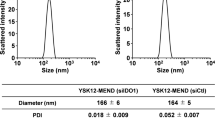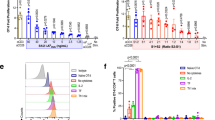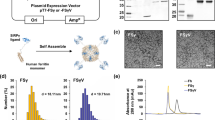Abstract
Leukemic cells exert immunosuppressive effects that interfere with dendritic cell (DC) function and hamper effective antileukemic immune responses. Here, we sought to enhance the immunogenicity of leukemic cells by loading them with the double-stranded (ds) RNA Toll-like receptor 3 (TLR3) ligand polyriboinosinic polyribocytidylic acid (poly(I:C)), mimicking viral infection of the tumor cells. Given the responsiveness of DC to TLR ligands, we hypothesized that the uptake of poly(I:C)-loaded leukemic cells by immature DC (iDC) would lead to DC activation. Primary acute myeloid leukemia (AML) cells and AML cell lines markedly responded to poly(I:C) electroporation by apoptosis, upregulation of TLR3 expression, enhanced expression of major histocompatibility complex (MHC) and costimulatory molecules and by production of type I interferons (IFN). Upon phagocytosis of poly(I:C)-electroporated AML cells, DC maturation and activation were induced as judged by an increased expression of MHC and costimulatory molecules, production of proinflammatory cytokines and an increase of T helper 1 (TH1)-polarizing capacity. These immune effects were suboptimal when AML cells were passively pulsed with poly(I:C), indicating the superiority of poly(I:C) transfection over pulsing. Our results demonstrate that poly(I:C) electroporation is a promising strategy to increase the immunogenicity of AML cells and to convert iDC into activated mature DC following the phagocytosis of AML cells.
This is a preview of subscription content, access via your institution
Access options
Subscribe to this journal
Receive 12 print issues and online access
$259.00 per year
only $21.58 per issue
Buy this article
- Purchase on Springer Link
- Instant access to full article PDF
Prices may be subject to local taxes which are calculated during checkout



Similar content being viewed by others
References
Deschler B, Lubbert M . Acute myeloid leukemia: epidemiology and etiology. Cancer 2006; 107: 2099–2107.
Stripecke R, Levine AM, Pullarkat V, Cardoso AA . Immunotherapy with acute leukemia cells modified into antigen-presenting cells: ex vivo culture and gene transfer methods. Leukemia 2002; 16: 1974–1983.
Galea-Lauri J . Immunological weapons against acute myeloid leukaemia. Immunology 2002; 107: 20–27.
Chan L, Hardwick NR, Guinn BA, Darling D, Gaken J, Galea-Lauri J et al. An immune edited tumour versus a tumour edited immune system: prospects for immune therapy of acute myeloid leukaemia. Cancer Immunol Immunother 2006; 55: 1017–1024.
Cheuk AT, Chan L, Czepulkowski B, Berger SA, Yagita H, Okumura K et al. Development of a whole cell vaccine for acute myeloid leukaemia. Cancer Immunol Immunother 2006; 55: 68–75.
Arceci RJ . The potential for antitumor vaccination in acute myelogenous leukemia. J Mol Med 1998; 76: 80–93.
Hirano N, Takahashi T, Takahashi T, Ohtake S, Hirashima K, Emi N et al. Expression of costimulatory molecules in human leukemias. Leukemia 1996; 10: 1168–1176.
Koya RC, Kasahara N, Pullarkat V, Levine AM, Stripecke R . Transduction of acute myeloid leukemia cells with third generation self-inactivating lentiviral vectors expressing CD80 and GM-CSF: effects on proliferation, differentiation, and stimulation of allogeneic and autologous anti-leukemia immune responses. Leukemia 2002; 16: 1645–1654.
Hoebe K, Janssen E, Beutler B . The interface between innate and adaptive immunity. Nat Immunol 2004; 5: 971–974.
Reis e Sousa . Activation of dendritic cells: translating innate into adaptive immunity. Curr Opin Immunol 2004; 16: 21–25.
Iwasaki A, Medzhitov R . Toll-like receptor control of the adaptive immune responses. Nat Immunol 2004; 5: 987–995.
Mazzoni A, Segal DM . Controlling the Toll road to dendritic cell polarization. J Leukoc Biol 2004; 75: 721–730.
Rock FL, Hardiman G, Timans JC, Kastelein RA, Bazan JF . A family of human receptors structurally related to Drosophila Toll. Proc Natl Acad Sci USA 1998; 95: 588–593.
Takeda K, Kaisho T, Akira S . Toll-like receptors. Annu Rev Immunol 2003; 21: 335–376.
Alexopoulou L, Holt AC, Medzhitov R, Flavell RA . Recognition of double-stranded RNA and activation of NF-κB by Toll-like receptor 3. Nature 2001; 413: 732–738.
Yoneyama M, Kikuchi M, Natsukawa T, Shinobu N, Imaizumi T, Miyagishi M et al. The RNA helicase RIG-I has an essential function in double-stranded RNA-induced innate antiviral responses. Nat Immunol 2004; 5: 730–737.
Gitlin L, Barchet W, Gilfillan S, Cella M, Beutler B, Flavell RA et al. Essential role of mda-5 in type I IFN responses to polyriboinosinic:polyribocytidylic acid and encephalomyocarditis picornavirus. Proc Natl Acad Sci USA 2006; 103: 8459–8464.
Diebold SS, Montoya M, Unger H, Alexopoulou L, Roy P, Haswell LE et al. Viral infection switches non-plasmacytoid dendritic cells into high interferon producers. Nature 2003; 424: 324–328.
Michiels A, Breckpot K, Corthals J, Tuyaerts S, Bonehill A, Heirman C et al. Induction of antigen-specific CD8(+) cytotoxic T cells by dendritic cells co-electroporated with a dsRNA analogue and tumor antigen mRNA. Gene Ther 2006; 13: 1027–1036.
Schulz O, Diebold SS, Chen M, Naslund TI, Nolte MA, Alexopoulou L et al. Toll-like receptor 3 promotes cross-priming to virus-infected cells. Nature 2005; 433: 887–892.
McBride S, Hoebe K, Georgel P, Janssen E . Cell-associated double-stranded RNA enhances antitumor activity through the production of type I IFN. J Immunol 2006; 177: 6122–6128.
Van Tendeloo VF, Ponsaerts P, Lardon F, Nijs G, Lenjou M, Van Broeckhoven C et al. Highly efficient gene delivery by mRNA electroporation in human hematopoietic cells: superiority to lipofection and passive pulsing of mRNA and to electroporation of plasmid cDNA for tumor antigen loading of dendritic cells. Blood 2001; 98: 49–56.
Saikh KU, Lee JS, Kissner TL, Dyas B, Ulrich RG . Toll-like receptor and cytokine expression patterns of CD56+ T cells are similar to natural killer cells in response to infection with Venezuelan equine encephalitis virus replicons. J Infect Dis 2003; 188: 1562–1570.
Kaiser WJ, Offermann MK . Apoptosis induced by the toll-like receptor adaptor TRIF is dependent on its receptor interacting protein homotypic interaction motif. J Immunol 2005; 174: 4942–4952.
Iordanov MS, Ryabinina OP, Schneider P, Magun BE . Two mechanisms of caspase 9 processing in double-stranded RNA- and virus-triggered apoptosis. Apoptosis 2005; 10: 153–166.
Salaun B, Coste I, Rissoan MC, Lebecque SJ, Renno T . TLR3 can directly trigger apoptosis in human cancer cells. J Immunol 2006; 176: 4894–4901.
Harrison BD, Adams JA, Briggs M, Brereton ML, Yin JA . Stimulation of autologous proliferative and cytotoxic T-cell responses by “leukemic dendritic cells” derived from blast cells in acute myeloid leukemia. Blood 2001; 97: 2764–2771.
Vialle-Castellano A, Gaugler B, Mohty M, Isnardon D, van Baren N, Olive D . Abundant expression of fibronectin is a major feature of leukemic dendritic cells differentiated from patients with acute myeloid leukemia. Leukemia 2004; 18: 426–433.
Kharfan-Dabaja M, Ayala E, Lindner I, Cejas PJ, Bahlis NJ, Kolonias D et al. Differentiation of acute and chronic myeloid leukemic blasts into the dendritic cell lineage: analysis of various differentiation-inducing signals. Cancer Immunol Immunother 2005; 54: 25–36.
Fujita H, Asahina A, Mitsui H, Tamaki K . Langerhans cells exhibit low responsiveness to double-stranded RNA. Biochem Biophys Res Commun 2004; 319: 832–839.
Harii N, Lewis CJ, Vasko V, McCall K, Benavides-Peralta U, Sun X et al. Thyrocytes express a functional toll-like receptor 3: overexpression can be induced by viral infection and reversed by phenylmethimazole and is associated with Hashimoto's autoimmune thyroiditis. Mol Endocrinol 2005; 19: 1231–1250.
Kawai T, Akira S . Innate immune recognition of viral infection. Nat Immunol 2006; 7: 131–137.
Miettinen M, Sareneva T, Julkunen I, Matikainen S . IFNs activate toll-like receptor gene expression in viral infections. Genes Immun 2001; 2: 349–355.
Doyle SE, O'Connell R, Vaidya SA, Chow EK, Yee K, Cheng G . Toll-like receptor 3 mediates a more potent antiviral response than Toll-like receptor 4. J Immunol 2003; 170: 3565–3571.
Farina C, Krumbholz M, Giese T, Hartmann G, Aloisi F, Meinl E . Preferential expression and function of Toll-like receptor 3 in human astrocytes. J Neuroimmunol 2005; 159: 12–19.
Tissari J, Siren J, Meri S, Julkunen I, Matikainen S . IFN-alpha enhances TLR3-mediated antiviral cytokine expression in human endothelial and epithelial cells by up-regulating TLR3 expression. J Immunol 2005; 174: 4289–4294.
Sauter B, Albert ML, Francisco L, Larsson M, Somersan S, Bhardwaj N . Consequences of cell death: exposure to necrotic tumor cells, but not primary tissue cells or apoptotic cells, induces the maturation of immunostimulatory dendritic cells. J Exp Med 2000; 191: 423–434.
Spisek R, Chevallier P, Morineau N, Milpied N, Avet-Loiseau H, Harousseau JL et al. Induction of leukemia-specific cytotoxic response by cross-presentation of late-apoptotic leukemic blasts by autologous dendritic cells of nonleukemic origin. Cancer Res 2002; 62: 2861–2868.
Gallucci S, Lolkema M, Matzinger P . Natural adjuvants: endogenous activators of dendritic cells. Nat Med 1999; 5: 1249–1255.
Blander JM, Medzhitov R . Toll-dependent selection of microbial antigens for presentation by dendritic cells. Nature 2006; 440: 808–812.
Van Tendeloo VF, Van Broeckhoven C, Berneman ZN . Gene-based cancer vaccines: an ex vivo approach. Leukemia 2001; 15: 545–558.
Acknowledgements
This work was supported by grants # G.0456.03, G.0313.01 and WO.012.02 of the Fund for Scientific Research – Flanders, Belgium (FWO-Vlaanderen), by research grants of the Foundation against Cancer (BFK) Belgium and by a grant of the Antwerp University Concerted Research Action (BOF-GOA). VFIVT and PP are postdoctoral fellows of the Research Foundation – Flanders, Belgium (FWO-Vlaanderen). ELJM Smits is a Research Assistant of the FWO-Vlaanderen.
Author information
Authors and Affiliations
Corresponding author
Additional information
Supplementary Information accompanies the paper on the Leukemia website (http://www.nature.com/leu)
Supplementary information
Rights and permissions
About this article
Cite this article
Smits, E., Ponsaerts, P., Van de Velde, A. et al. Proinflammatory response of human leukemic cells to dsRNA transfection linked to activation of dendritic cells. Leukemia 21, 1691–1699 (2007). https://doi.org/10.1038/sj.leu.2404763
Received:
Revised:
Accepted:
Published:
Issue Date:
DOI: https://doi.org/10.1038/sj.leu.2404763
Keywords
This article is cited by
-
The progress and current status of immunotherapy in acute myeloid leukemia
Annals of Hematology (2017)
-
TLR-3 stimulation improves anti-tumor immunity elicited by dendritic cell exosome-based vaccines in a murine model of melanoma
Scientific Reports (2015)
-
Interferon-α in acute myeloid leukemia: an old drug revisited
Leukemia (2011)
-
Poly(I:C)-induced tumour cell death leads to DC maturation and Th1 activation
Cancer Immunology, Immunotherapy (2011)
-
Clinical evaluation of cellular immunotherapy in acute myeloid leukaemia
Cancer Immunology, Immunotherapy (2011)



